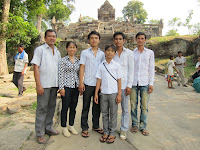



The Preah Vihear Temple or Prasat Preah Vihear (Khmer: ប្រាសាទព្រះវិហារ, Prasat Preah Vihear) is a Khmer temple situated atop a 525-metre (1,722 ft) cliff in the Dângrêk Mountains, in the Preah Vihear province of northern Cambodia and near the border of the Kantharalak district (amphoe) in the Sisaket province of eastern Thailand. In 1962, following a significant dispute between Thailand and Cambodia over ownership of the temple, the International Court of Justice (ICJ) in The Hague awarded the ownership to Cambodia.
Affording a view for many kilometers across a plain, Prasat Preah Vihear has the most spectacular setting of all the temples built during the six-centuries-long Khmer Empire. As a key edifice of the empire's spiritual life, it was supported and modified by successive kings and so bears elements of several architectural styles. Preah Vihear is unusual among Khmer temples in being constructed along a long north-south axis, rather than having the conventional rectangular plan with orientation toward the east. The temple gives its name to Cambodia's Preah Vihear province, in which it is now located, as well as the Khao Phra Wihan National Park which borders it in Thailand's Sisaket province, through which the temple is most easily accessible. On July 7, 2008, Preah Vihear was listed as a UNESCO World Heritage Site.[1]
[edit] Nomenclature
Preah Vihear is transliterated into Thai as Prasat Phra Viharn (ปราสาทพระวิหาร) or Prasat Khao Phra Viharn (ปราสาทเขาพระวิหาร) [In Thai the"Ph" is pronounced simply "p"]. Prasat (ប្រាសាទ) has the same meaning in Khmer,Thai, and Sanskrit ("castle", sometimes "temple"; in Sanskrit प्रासाद), and Khao is the Thai word for "hill" or "mountain" (in Khmer: "phnom" (ភ្នំ), Cambodians occasionally refer to "Phnom Preah Vihear" (ភ្នំព្រះវិហារ) as Thais usually refer to "Khao Phra Viharn"). The words "Preah" (ព្រះ) and "Phra" (พระ) mean "sacred", and the words "Vihear" (វិហារ)/"Viharn" (วิหาร) mean "shrine" (the central structure of the temple). In Thai, the word "khao" (เขา) has recently (as of 2008) been omitted from the name in order to differentiate between the temple and the cliff it is built on. Thai mass media appear to have begun this convention. The word Vihear could be related to the Sanskrit word Vihara (विहार) which means "abode."
The two versions of the name carry significant political and national connotations (see below: New dispute over ownership).
[edit] Location
The temple sits atop Pey Tadi, a cliff in the Dângrêk Mountains which straddle the border between Thailand and Cambodia. During different periods it has been located in Cambodia and Thailand in turn. Following Cambodian independence and the Thai occupation of the temple it was listed by Thailand as being in Bhumsrol village (which means "village of pine trees") of Bueng Malu sub-district (now merged with Sao Thong Chai sub-district), in the Kantharalak district of the Sisaket province of eastern Thailand. It is 110 km from the Mueang Si Sa Ket district, the center of Si Sa Ket province.
After the 1962 ICJ majority ruling that it belonged to Cambodia settled ownership of the temple, it was listed as being in Svay Chrum Village, Kan Tout Commune, in Choam Khsant District of Preah Vihear province of northern Cambodia. The temple is 140 km from Angkor Wat and 320 km from Phnom Penh. [2]